By Neala Fugere Yellowstone Forever
Your breath freezes in the frigid January air; last you checked, the thermometer in your vehicle read 25 F. Your hand instinctively wraps around the camera battery you’ve placed in your pocket as you wait patiently next to your tripod. Through binoculars, you notice an anticipated movement against the snowy landscape. Action! You rush to ready your camera, and within seconds you are capturing a pair of wolves—wild wolves—silhouetted perfectly against the blanket of white.
It’s a rare scene like this that motivates many photographers to come to Yellowstone, according to Meg Sommers, a professional photographer and Yellowstone Forever Institute instructor. The longtime resident of Cody, Wyoming, has been helping institute students photograph Yellowstone since 2010. For Sommers, winter is an exceptional time to tell stories of the natural world through photography—wildlife is easier to spot against the snow. Even the landscape offers something new and spectacular, she said, where “frost can turn a blade of grass into something extraordinary.”
But capturing these winter images comes with challenges. Sommers explains that photographers should be prepared to keep warm in sub-zero temperatures—knowing they may have to stay in one place for hours waiting for that perfect moment. She recommends wearing layers and bringing along hand warmers, as well as becoming familiar with the area they’ll be photographing.
In terms of equipment, Sommers advises all serious photographers have a good camera body, a sturdy tripod, and a selection of lenses—both shorter and longer for landscapes and wildlife, respectively—as well as a solid understanding of their camera’s settings.
The equipment itself can present its own set of difficulties in winter, Sommers warns. Prolonged exposure to frigid temperatures can quickly zap the life out of batteries; she recommends keeping them in your pocket for warmth. Photographers should take care when they head back indoors, as the humidity in the warmer air will condense on the equipment. To prevent this, she suggests placing everything in a sealable bag—like a large Ziploc—before moving indoors.
Wildlife photographers should also come to Yellowstone prepared with ample patience and respect for the wildlife they’re hoping to photograph. Learning to wait for that magic moment will get easier the more times you’re rewarded with a special image, Sommers says. The park requires all visitors to maintain a distance of at least 25 yards from wildlife and 100 yards from bears and wolves, both for the safety of the photographer and the wildlife.
With these tips in mind, Yellowstone’s winter world is wide open for those yearning to capture its unique beauty and the wildlife that call it home. For Sommers, photographing the wonders of the park in the winter is the perfect way to connect to the landscape, and well worth the inherent challenges. “The lucky photographer will find animal behavior to photograph that helps to convey a story, giving us some small insight into what life is like in that moment in time,” she said.
For those ready to take their winter photography skills to the next level while experiencing Yellowstone’s winter wilderness, the Yellowstone Forever Institute is offering a trio of photography-themed field seminars this winter. All courses are based at the Lamar Buffalo Ranch in Yellowstone’s famed Lamar Valley and feature expert instructors.
Photography Rendezvous: Dec. 10-13
Instructors Dale and Angela Bohlke will guide you in capturing the stark and moving landscape of Lamar Valley in winter, and you’ll leave with a collection of your own inspiring Yellowstone photographs. In the field, you’ll practice techniques for capturing unique wildlife and landscape images. In the classroom, you’ll learn how to simplify your camera settings, process images for maximum effect, and realize your creative potential.
The Art of Winter Landscape Photography: Jan. 23-26
Let the grand winter landscape of Yellowstone be your muse in this intensive workshop for intermediate to advanced photographers. With instructors Terry Donnelly and Tom Kirkendall, learn composition and processing tools that will expand your ability to see, create and communicate your visual understanding of the landscape. In the field, you’ll explore the best options for light, lens choice and perspective. In the classroom, you’ll hone your Photoshop and raw file processing skills, learning workflow techniques commonly used by professionals.
Winter Wildlife Photography: Jan. 30 to Feb. 2
For novice and veteran photographers alike, here’s your chance to photograph Yellowstone’s spectacular winter wildlife. With instructor Meg Sommers, you’ll spend most of your time in the field, finding and photographing many diverse types of winter inhabitants. You’ll also practice photographic fundamentals, techniques and the ethics of wildlife photography. In class sessions, you’ll focus on composition, lighting, equipment and computer skills.
Learn more about these and other field seminars at yellowstone.org/experience.
A version of this story was originally published in the winter 2017 edition of Yellowstone Quarterly.













